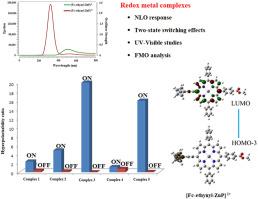Journal of Molecular Graphics and Modelling ( IF 2.7 ) Pub Date : 2021-06-25 , DOI: 10.1016/j.jmgm.2021.107975 Tamseela Bibi 1 , Tabish Jadoon 2 , Shabbir Muhammad 3 , Khurshid Ayub 1

|
Designing switchable materials with large contrasts of nonlinear optical properties has been the focus of research in recent decades because of their widespread applications. Redox-active metal complexes due to charge transfer excitation are suitable to produce switchable nonlinear optical (NLO) material. In this regard, we present here the redox switchable NLO response of active metal complexes of iron and cobalt. The geometric, electronic, molecular absorption, nonlinear optical properties, and switch “ON/OFF” style of these metal complexes are studied at the CAM-B3LYP/6-31 + G(d) level of theory. NLO responses of these redox metal complexes are described in terms of change in the charge transfer (CT) patterns by time dependent density functional theory (TD-DFT). The highest value of 301534 × 10−30 esu is noticed in [Fe-ethynyl-ZnP]1+ complex, because of obvious charge transfer transition from metal to ligand i.e meatal-ligand charge transfer (MLCT) in redox metal complex. In each redox metal isomeric pair, the greater hyperpolarizability value of individual isomer is quite consistent with its smaller energy gap (H-Lgap) between highest occupied molecular orbital (HOMO) to the lowest unoccupied molecular orbital (LUMO), low crucial excitation energy, and bathochromic shift of . The remarkable contrasts of these isomeric redox complexes illustrate that they can be appropriate for effective redox-triggered NLO switches. Thus, the results reveal that these redox pair complexes show two-state switching “ON/OFF” effect.
中文翻译:

铁钴过渡金属氧化还原配合物的二阶非线性光学特性和双态转换效应:DFT 研究
由于其广泛的应用,设计具有大非线性光学特性对比的可切换材料一直是近几十年来研究的重点。由于电荷转移激发而产生的氧化还原活性金属配合物适用于生产可切换的非线性光学 (NLO) 材料。在这方面,我们在这里介绍了铁和钴的活性金属络合物的氧化还原可切换 NLO 响应。在 CAM-B3LYP/6-31 + G(d) 理论水平上研究了这些金属配合物的几何、电子、分子吸收、非线性光学特性和开关“开/关”风格。这些氧化还原金属配合物的 NLO 响应是根据时间相关密度泛函理论 (TD-DFT) 的电荷转移 (CT) 模式变化来描述的。最高 在[Fe-乙炔基-ZnP] 1+ 配合物中注意到301534 × 10 -30 esu 的值,因为从金属到配体的明显电荷转移,即氧化还原金属配合物中的金属配体电荷转移(MLCT)。在每个氧化还原金属异构体对中,单个异构体的较大超极化值与其最高占据分子轨道 (HOMO) 与最低未占据分子轨道 (LUMO) 之间的较小能隙 (H-Lgap)、低临界激发能、和红移. 非凡的这些异构氧化还原复合物的对比说明它们适用于有效的氧化还原触发 NLO 开关。因此,结果表明这些氧化还原对复合物显示出两态切换“开/关”效应。











































 京公网安备 11010802027423号
京公网安备 11010802027423号